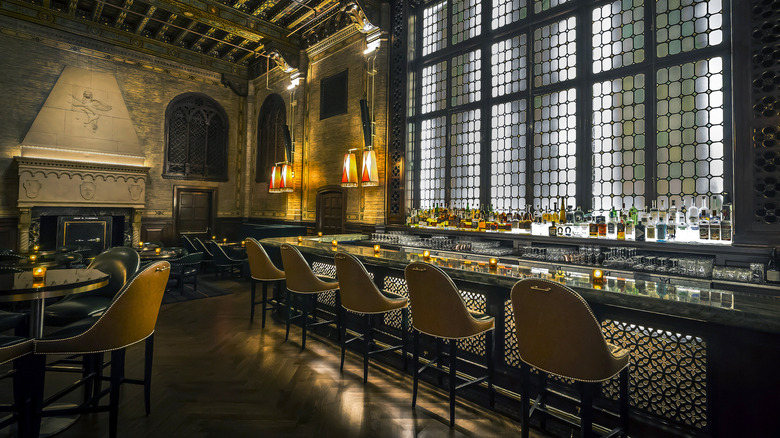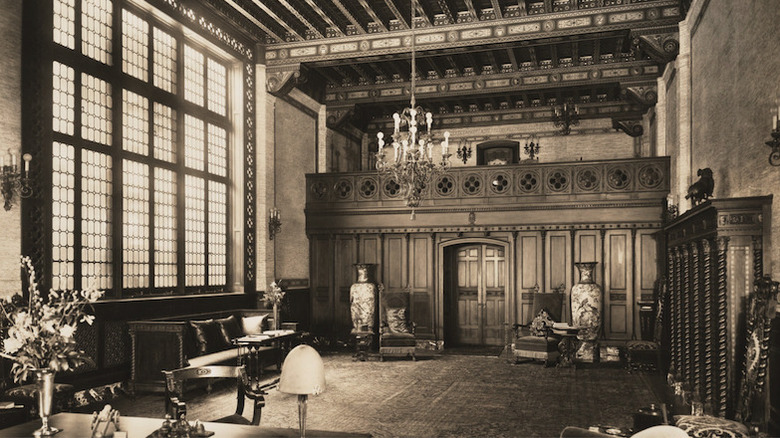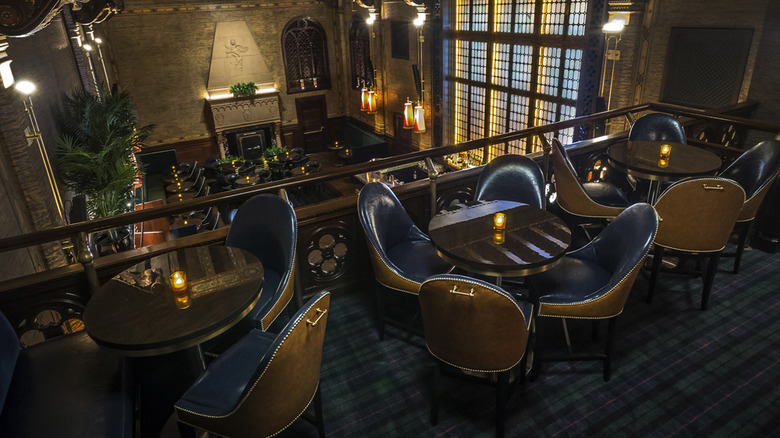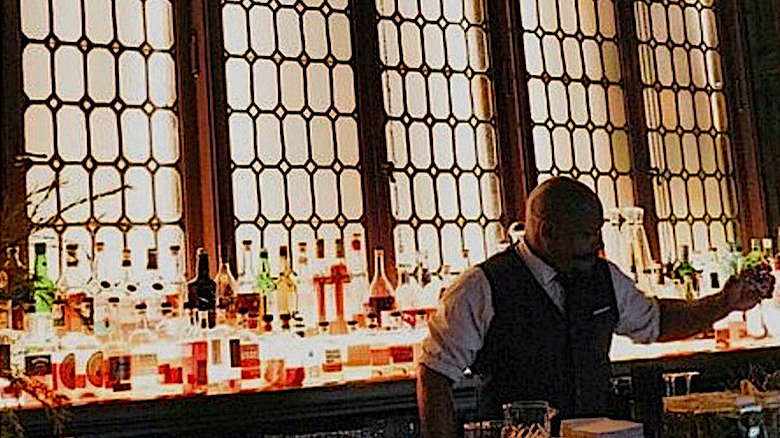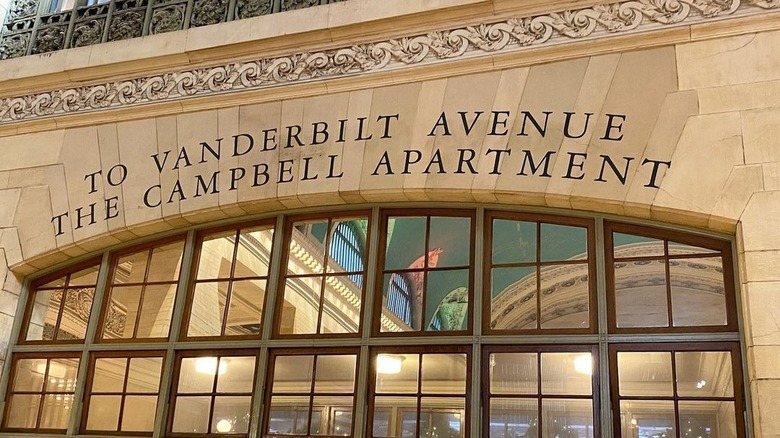The Not-So-Secret Secret Bar At Grand Central Terminal
It's not quite as out of sight as the Harry Potter Platform 9 ¾ at London's King's Cross Station, but it still takes a bit of sleuthing to find the entrance to The Campbell at New York City's Grand Central Terminal. And although the passage, once you find it, won't lead to the boarding platform for a magical train ride to Hogwarts School of Witchcraft and Witchery, the doorway does seemingly transport patrons across the threshold to a different place and time — a hidden bar reminiscent of a 1920s speakeasy.
The story begins with John W. Campbell, an early 20th-century financier who held a seat on the board of the New York Central Railroad. In search of a location to build a lavish workplace in keeping with his social and professional status, Campbell leased space on the ground floor at Grand Central Station and commissioned Augustus N. Allen to design an ornate office. Allen, who was known for creating elegant decor for turn-of-the-century Long Island mansions — think "Great Gatsby" — transformed the 3,500-square-foot space into what Grand Central Terminal describes as a "13th-century Florentine-inspired design" with on-point details including "25-foot hand-painted ceilings, a grand stone fireplace ... and a century-old leaded glass window." According to Town & Country, Campbell spared no expense, furnishing his opulent office with a piano and a pipe organ, Italian-made furniture, and a $300,000 Persian rug that would be worth close to $5.3 million in today's dollars.
Gone, but not forgotten
Following Campbell's death in 1957, the grand office fell into disrepair. A utilitarian drop ceiling was installed to conceal Campbell's massive 25-foot hand-painted ceiling, leaded glass windows were covered with plywood, and furnishings — including the pricey Persian rug — disappeared as the space was alternately repurposed over the course of four decades to serve as a signalman's office, a place for police to store their guns, and even a jail holding cell. Finally, in the early 1990s, Mark Grossich, a leading investor in high-end hospitality venues, recognized the architectural jewel hidden under more than 40 years of accumulated dust and detritus.
The owner of Hospitality Holdings, Grossich leased the space from the Metropolitan Transportation Authority at an agreed-upon annual rate of $350,000, spent $2.5 million bringing it back to its former glory, and named it the Campbell Apartment — a reference to its size and the fact that Campbell's original layout included a bathroom and small kitchen. (Although, there's no evidence it was ever used as an apartment.)
When the restaurant debuted in 1999, Grossich instituted a dress code banning athletic shoes, baseball caps, T-shirts, and other casual attire — a move that likely enhanced its stature among traditionalists at a time when the athleisure movement was gaining traction in American social circles — and opened the long-shuttered space to the public. ... At least to members of the public who could find the entrance tucked in a corner adjacent to the Vanderbilt Avenue side of the massive train station.
And almost gone again
In a move that took Grossich by surprise, the transportation authority decided in 2016 to review the year-to-year lease and open it to the highest bidder. Grossich and Hospitality Holdings offered $800,000 annually for a 10-year lease. A rival company, Gerber Group, offered $1.1 million. An acrimonious legal battle ensued until, in 2017, a court sided with the transportation authority, paving the way for Gerber Group to take over the space. Despite the public outcry in support of Grossich, the proprietor graciously stepped aside, telling Town & Country at the time, "I've been fortunate to run it all these years, and I'm delighted that it's become a world-class iconic venue that will probably outlive all of us."
Meanwhile, Scott Gerber of Gerber Group, announced plans to maintain the cocktail bar's elegant atmosphere while relaxing the dress code, telling Town & Country, "The way people dress today for work and pleasure has changed over time, and in some cases become more casual. Since we create our bars and restaurants to be inclusive as opposed to exclusive, we want everyone to feel welcome." Fast forward to today, and it's clear Gerber kept his promise.
According to The Spaces, the iconic bar, renamed simply The Campbell, remains true to its roots with original features including the coffered ceilings, leaded windows, and even the steel safe John W. Campbell kept hidden in the massive fireplace on full display.
A familiar face behind the bar
Long-time Campbell Apartment bartender Paris DuRante returned to the fold and continues to delight visitors at The Campbell with cocktails like Prohibition Punch, a boozy blend of rum, Gran Gala, passionfruit juice, cranberry juice, and lemon juice — or maybe a classic Manhattan. "Paris is one of our wonderful bartenders," Courtney Martin, general manager of The Campbell, told Tasting Table. "He opened the property when it was The Campbell Apartment, and has stayed with us since. You can find him behind the bar during the week making the best Manhattans you have ever had."
A native New Yorker, DuRante served in the U.S. Air Force before finding his calling behind the bar more than three decades ago. In 2015, during his tenure at the Campbell Apartment, DuRante told The New York Times, "I really have met so many of my dearest friends working in bars. Bars are the great social leveler. People from all walks of life walk in, and you're all just the same."
Walk this way
In other words, if you find the discreet entrance to The Campbell, there's a good chance you'll also find a friendly face waiting behind the bar, along with a blend of patrons ranging from locals who consider it their neighborhood watering hole to visitors and commuters passing through Grand Central Terminal. "We still have a lot of guests who come in and are surprised to find the bar," Courtney Martin told Tasting Table. "Even if it isn't as mysterious as it once used to be, there is still an 'insider' vibe when you come to visit."
Intrigued? The Gerber Group installed signage making it easier to find the entrance to The Campbell and added a seasonal outdoor venue — The Campbell Terrace — at the location of the previously hidden-in-plain-sight doorway. The secret? Although The Campbell is located at Grand Central Terminal, patrons enter from outside the building at 15 Vanderbilt Ave., a stone's throw to the right of the junction where East 43rd Street ends at Grand Central Terminal. But that's no fun. For a more authentic experience, start in the terminal's ornate main concourse and climb a marble staircase to the Vanderbilt Avenue egress. Proceed through the exit, turn left, and enter through Campbell Terrace.
